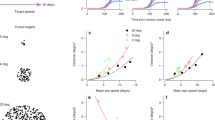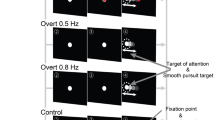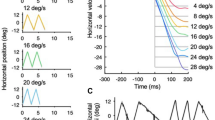Abstract
THE traditional explanation1 of visual tracking has been that smooth tracking by the eyes depends on the presence of a moving retinal image at or near the fovea. However, evidence is steadily accumulating suggesting that this explanation is incomplete2. The presence of an extrafoveal afterimage or stabilised retinal image in certain circumstances suffice to initiate smooth tracking movements3–5; observers are able to track, in the dark, the position of their own hand6 or of a moving sound source7 and may, after considerable practice, be able to generate sinusoidal tracking movements purely voluntarily4,8. We describe here a perceptual effect apparently created by the generation of smooth horizontal tracking eye movements, in the absence of a target, by observers regarding a display of dynamic visual noise. We interpret this effect in terms of the presence within random visual noise of features which lead to the neuronal representation of movement at some unspecified level of organisation of the visual system.
This is a preview of subscription content, access via your institution
Access options
Subscribe to this journal
Receive 51 print issues and online access
$199.00 per year
only $3.90 per issue
Buy this article
- Purchase on Springer Link
- Instant access to full article PDF
Prices may be subject to local taxes which are calculated during checkout
Similar content being viewed by others
References
Aschoff, J. C. in The Neurosciences: Third Study Program (eds Schmitt F. O. & Worden F. G.) 305–310 (MIT Press, Cambridge, Massachusetts, 1974).
Young, L. R. in Control of Gaze by Brain Stem Neurons (eds Baker R. & Berthoz A.) 29–36 (North-Holland, Amsterdam, 1977).
Robinson, D. A. J. Physiol., Lond. 180, 569–591 (1965).
Kommerell, G. & Taümer, R. Bibl. ophthal. 82, 288–297 (1972).
Yasui, S. & Young, L. R. Science 190, 906–908 (1975).
Steinbach, M. J. Vision Res. 16, 1371–1376 (1976).
Gauthier, G. M. & Hofferer, J. M. Exp. Brain Res. 26, 121–139 (1976).
Westheimer, G. & Conover, D. W. J. exp. Psychol. 47, 283–284 (1954).
Findlay, J. M. Q. J. exp. Psychol. 26, 167–170 (1974).
Tyler, C. W. Nature 250, 781–782 (1974).
Ross, J. Nature 248, 363–364 (1974).
Pulfrich, C. Naturwissenschaft 10, 553–564 (1922).
Morgan, M. J. & Thompson, P. Perception 4, 3–18 (1975).
Mezrich, J. R. & Rose, A. Vision Res. 17, 903–910 (1977).
Lamontagne, C. Perception 2, 167–180 (1973).
Heywood, S. Perception 2, 181–195 (1973).
Baker, R. & Berthoz, A. (eds) Control of Gaze by Brain Stem Neurons (North-Holland, Amsterdam, 1977).
Schneider, G. E. Psychol. Forsch. 31, 52–62 (1967).
Author information
Authors and Affiliations
Rights and permissions
About this article
Cite this article
WARD, R., MORGAN, M. Perceptual effect of pursuit eye movements in the absence of a target. Nature 274, 158–159 (1978). https://doi.org/10.1038/274158a0
Received:
Accepted:
Issue Date:
DOI: https://doi.org/10.1038/274158a0
Comments
By submitting a comment you agree to abide by our Terms and Community Guidelines. If you find something abusive or that does not comply with our terms or guidelines please flag it as inappropriate.



